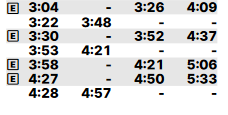Delvin4519
Active Member
- Joined
- Oct 8, 2022
- Messages
- 884
- Reaction score
- 1,536
The Fall 2024 schedule started on August 25th, 2024.Man, I waited for almost half an hour for the 86 today. I dont know if those schedule upgrades have been made yet, I hope they haven't, because if they have, this is still not a service with frequency that will ever attract spur-of-the-moment riders. We need so much more investment in public transit, it's not even funny.
The 86 is scheduled for 30 minute headways weekdays and Saturdays, and 40 on Sundays and evenings.
/begin rhectorical rant
It is getting more and more worrying and concerning the MBTA is STILL, STILL, plowing "full steam ahead" for "December 15th, 2024" of "BNRD phase 1". The latest August 28th, 2024 post shows the MBTA still holding their goalpost in place.
Why is this worrying and concerning? Well, the T has allegedly filled 100 of their 300 or so vacancies over the course of 13 months. Scheduled service levels have hardly changed with half of the routes gaining service and the other half getting service trimmed and cut back. This leaves bus service almost unchanged at ~85-86% of pre-COVID levels for over 13-14 months now, despite over a year of work of filling the vacancies. If it's this bad, surely the T should give an indication it should need additional time, perhaps until April 6, 2025, before beginning BNRD. It would be the right thing to do for the MBTA to ensure all vacancies get filled, every single last vacancy down into the single digits, a full pre-COVID strong force running the buses once again for the first time since 2019, before moving full steam into BNRD.
The T plans to begin BNRD with on the order of 250 or so unfilled vacancies.... Such a disturbing motive. If there's 200 vacancies, 300 below the FY24/25 ceiling, or somehow still 700 below BNRD levels after all this time, you don't have enough operators for BNRD round 1!!! 1,867 as the ceiling from FY24 should mean 1,700-1,750 of those would be on the road (allowing 100-115 to be inactive for various reasons).... restoring a more off peak-peak balanced version of pre-COVID service for non-BNRD routes alongside, improved BNRD round 1 routes.
The T has CANCELLED the board subcommittee meetings YET AGAIN!!! This means the T won't provide an update on their utter disaster of something on the order of 225 vacancies as of July 2024. The T needs to fix their goalposts and aim for 1,750, not 1,560 before beginning BNRD, leaving approx 117 below the budgeted ceiling (last reported for FY24 as 1,867), for various inactive needs.
/end rhectorical rant
Perhaps @StreetsblogMASS may be able to figure out what's going on. This really needs actual answers.
(I'm just frustrated, forum members don't need to reply here (its literally marked as "rhectorical", I already read and saw the guesses/theories when I first posted in the General MBTA thread, but it'd be interesting if StreetsBLOG has comments or not. But, man, an update from StreetsBLOG could add some clarity)




